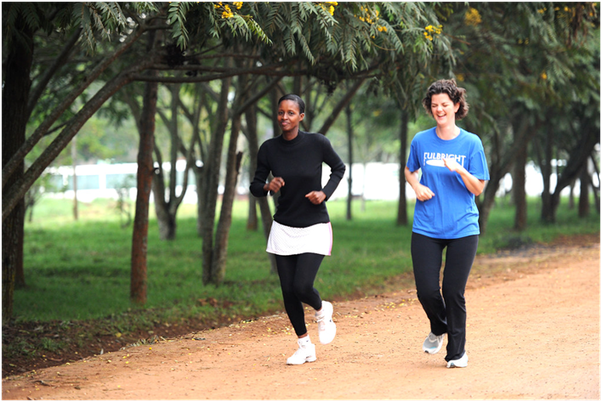Living with diabetes can feel like a constant battle with blood sugar levels. While exercise is often touted for its ability to manage blood sugar, its benefits extend far beyond mere glucose control. This comprehensive guide delves into the hidden advantages of incorporating physical activity into your life with diabetes, empowering you to experience a healthier and more fulfilling existence.
The Powerhouse of Exercise: Benefits Beyond the Blood Sugar Drop
Exercise is a potent weapon in your diabetes management arsenal. However, its impact goes deeper than influencing blood sugar levels. Here’s how regular physical activity can transform your well-being:
1. Enhanced Insulin Sensitivity:
- Exercise improves how your body uses insulin, the hormone responsible for ushering glucose (sugar) from your bloodstream into your cells for energy. This translates to better blood sugar control and reduced reliance on medication.
2. Improved Cardiovascular Health:
- Regular physical activity strengthens your heart muscle, lowers blood pressure, and improves blood flow. This reduces the risk of heart disease, a significant complication associated with diabetes.
3. Weight Management and Body Composition:
- Exercise burns calories and helps maintain a healthy weight, which plays a crucial role in diabetes management. It also promotes muscle growth, which further enhances insulin sensitivity and metabolic rate.
4. Boosted Energy Levels:
- Regular physical activity improves muscle efficiency and oxygen utilization, leading to increased energy levels throughout the day. You’ll feel more energized to tackle your daily tasks and embrace an active lifestyle.
5. Stronger Bones and Reduced Risk of Osteoporosis:
- Weight-bearing exercises like walking, jogging, or dancing put stress on your bones, promoting bone density and reducing the risk of osteoporosis, a condition where bones become weak and brittle.
6. Improved Mood and Reduced Stress:
- Exercise is a potent stress reliever. Physical activity triggers the release of endorphins, hormones with mood-boosting and pain-relieving properties. Regular exercise can help combat stress and anxiety, which can worsen blood sugar control.
7. Enhanced Sleep Quality:
- Physical activity can significantly improve sleep quality. Exercise helps you fall asleep faster, sleep more soundly, and wake up feeling refreshed. Better sleep patterns positively impact blood sugar control and overall well-being.
8. Increased Cognitive Function and Reduced Risk of Dementia:
- Exercise promotes blood flow to the brain, which can improve cognitive function, memory, and concentration. Regular physical activity can lower the risk of dementia and Alzheimer’s disease, conditions more prevalent in people with diabetes.
9. Improved Body Image and Self-Confidence:
- Engaging in physical activity and witnessing positive changes in your body can significantly boost your self-esteem and body image. This newfound confidence can translate into a more positive outlook and improved motivation towards managing your diabetes.
10. Stronger Immune System and Reduced Risk of Infections:
- Regular exercise can strengthen your immune system, making you less susceptible to infections and illnesses, which can pose additional challenges for people with diabetes.
Finding Your Fit: Exercise for Every Body with Diabetes
The beauty of exercise lies in its versatility. There’s a physical activity for everyone, regardless of fitness level or physical limitations. Here’s how to find your perfect fit:
1. Consult Your Doctor:
- Before starting any new exercise program, it’s crucial to consult with your doctor to ensure it’s safe and appropriate for your specific health condition and diabetes management plan.
2. Identify Activities You Enjoy:
- Exercise shouldn’t feel like a chore. Choose activities you genuinely enjoy, whether it’s dancing, swimming, walking, cycling, hiking, yoga, or team sports.
3. Start Slowly and Gradually Increase Intensity:
- Don’t try to do too much too soon. Begin with low-impact activities and gradually increase the duration and intensity as your fitness level improves.
- 4. Strength Training is Your Ally:
- Include strength training exercises 2-3 times a week to build muscle mass, which further enhances insulin sensitivity and improves overall fitness.
- 5. Find an Exercise Buddy or Group:
- Exercising with a friend or group can boost motivation, accountability, and make the experience more fun.
- 6. Make It Part of Your Daily Routine:
- Schedule your exercise sessions like any other important appointment. Consistency is key to reaping the long-term benefits.
Breaking Down Barriers: Overcoming Common Challenges:
- Lack of Time: Break down your exercise into smaller, more manageable chunks. Aim for 30-minute sessions or even 10-minute bursts throughout the day. You can take the stairs instead of the elevator, park farther away from your destination, or do some bodyweight exercises during commercial breaks while watching TV.
- Motivation: Find activities you enjoy and set realistic goals. Track your progress and celebrate your achievements. Consider joining a support group or finding an exercise buddy for added accountability.
- Fear of Injury: Start slowly and listen to your body. Choose low-impact activities initially and gradually increase intensity. Consult your doctor if you experience any pain or discomfort.
- Cost: Many free or low-cost exercise options exist, such as walking, bodyweight exercises, or using free workout videos online. Public parks, community centers, and YMCA facilities often offer affordable fitness programs.
Living an Empowered Life with Diabetes:
Exercise is a powerful tool for taking control of your diabetes and experiencing a healthier, happier you. Here are some additional tips to integrate exercise seamlessly into your life:
- Make it a Family Affair: Encourage your family to participate in physical activities together. This creates a supportive environment and promotes healthy habits for everyone.
- Find Activities You Can Do Anywhere: Bodyweight exercises like squats, lunges, push-ups, and planks require no equipment and can be done anywhere, anytime.
- Turn Errands into Workouts: Park farther away and walk to your destination, take the stairs instead of the elevator, or cycle to run errands.
- Make Exercise a Social Event: Join a walking group, a dance class, or a sports team. This adds a social element to your workout routine and can boost motivation.
- Reward Yourself: Celebrate your achievements, big or small. Treat yourself to a new workout outfit, a massage, or a healthy meal after reaching a fitness milestone.
Remember: Consistency is key. By incorporating physical activity into your daily routine, you’ll unlock a world of hidden benefits that extend far beyond blood sugar control. Embrace the power of exercise, and experience the joy of a healthier, more fulfilling life with diabetes.
Note: This article provides general information and should not be used as a substitute for professional medical advice. Always consult with your healthcare provider before starting a new exercise program.

 Diabetology2 weeks ago
Diabetology2 weeks ago
 Diabetology1 week ago
Diabetology1 week ago
 Diabetology5 days ago
Diabetology5 days ago
 Diabetology7 days ago
Diabetology7 days ago
 Diabetology7 days ago
Diabetology7 days ago
 Diabetology3 days ago
Diabetology3 days ago
 Diabetology3 days ago
Diabetology3 days ago
 Diabetology1 day ago
Diabetology1 day ago








